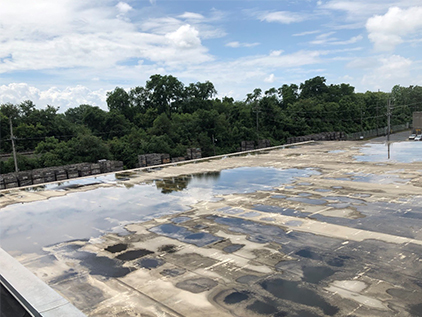Ponded Roof Case Study
The following photo case study is an interesting example of what happens when permeable membranes are left to hold ponded water for too long.
Ponded Roof Case Study
The following photo case study is an interesting example of what happens when permeable membranes are left to hold ponded water for too long.
Client: Knouse Foods: Lucky Leaf/Musselman’s Facility
Location: Chambersburg, PA
Roof Type: Modified Bitumen Membrane
Roof Age: 15 Years
Project Overview: Most roofs constructed before the mid 1990s do not have the current code compliance of a ¼ inch per foot slope. This code change was brought about by the single ply “revolution” of the 1980s. Formerly, most roofs were either dead level asphalt or ideally coal tar pitch built up roofs and most of those systems could competently hold ponded water well. The most popular single plies, EPDM and TPO, have perm factors that that allow ponded water to microscopically seep through. Occurring wherever ponded water builds up on any roof, this permeation leaking is insidious as it cannot be seen from below. Furthermore, the insulation within the roof system becomes saturated and will subsequently rust steel or spall concrete.
Roof Problems: Ponded Water. Wet Insulation. Spalling Concrete.
1—The Lucky Leaf/Musselman’s facility in Chambersburg, PA had a large dead level roof covered end to end by heavy ponding of up to 2”. Over time, pieces of lightweight concrete started to spall and hit personnel below, even though no overt leaking had been observed. Sure enough, the single ply membrane roof cover had let ponded water permeate every portion of the roof. Core samples revealed saturated insulation and damaged lightweight that was undetectable by simple observation. In short, a severe safety issue had evolved due to improper membrane choice. Additionally, the black roof had a low albedo rating over this cold storage building.
2—Many roof designers select a membrane based upon their relationships with one or two manufacturers. Worse, manufacturer’s reps are compelled to select from their own limited line, or in the case of several well-known companies, choose whatever membrane that generates the most commissions or profit for them. We see such results here.
Roofing Solution: This roof was surrounded by the fixed elevations of adjacent roof areas. Tapered insulation – always very expensive – could not be utilized without “re-inventing the wheel.” Prior experience in forensics, lab research, and design steered Roofing Dynamics to select a membrane conforming to ASTM 6754 Elvaloy standards. After extensive deck repairs, closed cell non-hygroscopic insulation was installed along with the new white Elvaloy membrane.
The Results: The roof system is in its 17th year. Subsequent infrared studies reveal no wet or even damp insulation. Roofing Dynamics continues to service Knouse Foods 5 facilities (2 million sq. ft.).
Ponded Roof

Typical dead-level flat roof. Because the adjacent building flashings were set low, tapered insulation could not be utilized.

Yet there was heavy ponding everywhere on the original roof, as you can see still exits on the new roof.

Only ASTM 6754 brand Elvaloy can hold this much ponding. This roof has not leaked in 17 years.


